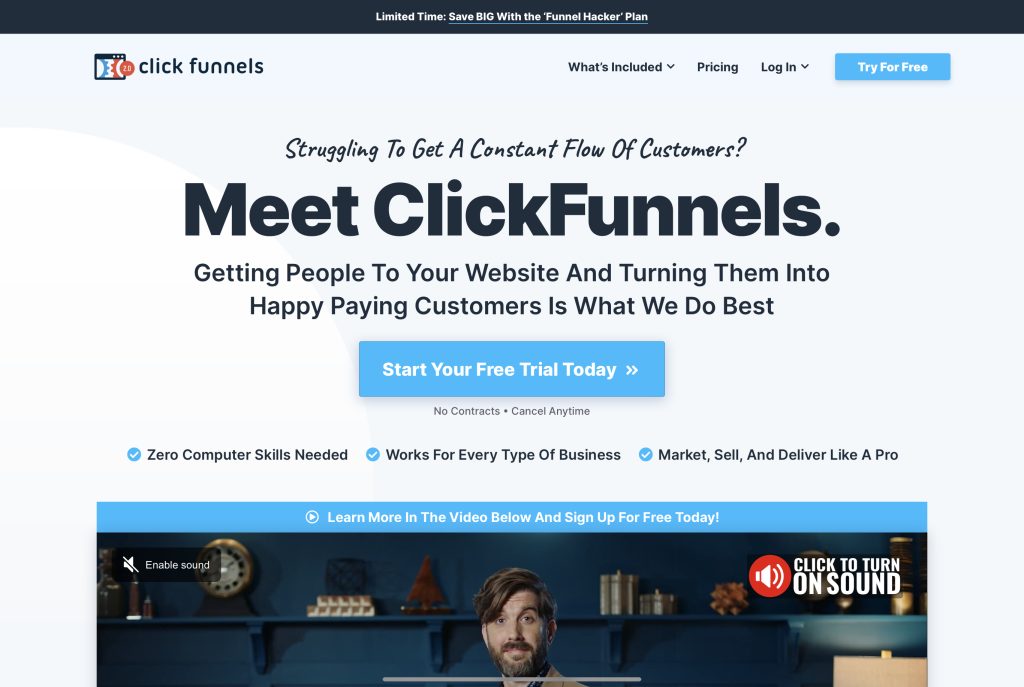Archive
ClickFunnels’ Backpack: Managing Your Affiliate Program Effectively
Hey there! As an affiliate marketer, I am always on the lookout for tools that can help me manage my affiliate program more effectively. And that’s where ClickFunnels’ Backpack comes in!
Backpack is ClickFunnels’ affiliate management system, and it’s designed to help you successfully run your affiliate program. With Backpack, you can easily create affiliate links, track clicks and sales, and pay your commissions all in one place.
One of the best things about Backpack is that it integrates seamlessly with ClickFunnels’ sales funnels. This means that you can create custom affiliate links for each of your funnels, and track how much traffic and sales each funnel generates.

But that’s not all. Backpack also includes a number of features that help you motivate your affiliates and increase sales. For example, you can set up leaderboards and contests to encourage your affiliates to promote your products more actively. You can also create custom commission plans and offer bonuses to your top performers.
Another great feature of Backpack is its reporting capabilities. You can easily view your affiliate program’s performance, including clicks, sales, and commissions. This information can help you identify which affiliates are performing well and which ones need more support.
Overall, I highly recommend ClickFunnels’ Backpack for anyone who wants to manage their affiliate program effectively. It’s easy to use, integrates seamlessly with ClickFunnels, and offers a wide range of features to help you motivate your affiliates and increase sales.
So if you’re looking for an affiliate management system that can help you streamline your program and boost your sales, give Backpack a try today!
This post may contain affiliate links, where I may receive a small commission if you purchase something through following the link at no cost to you.
Building Effective Sales Funnels: A Comprehensive Guide
Hey there! Are you struggling to make sales? Do you feel like you’re putting in a lot of effort but not seeing the results you want? You’re not alone. Many businesses struggle with this issue, but the good news is that there is a solution: building an effective sales funnel.
A sales funnel is a series of steps that a potential customer goes through before making a purchase. It’s important to note that not everyone who enters your sales funnel will end up making a purchase, but the goal is to increase the number of people who do. Here’s how to build an effective sales funnel:
Step 1: Identify your target audience
The first step in building an effective sales funnel is to identify your target audience. Who are the people who are most likely to be interested in your product or service? What are their pain points, and how can your product or service help solve them?

Step 2: Create a lead magnet
A lead magnet is something that you offer for free in exchange for someone’s contact information. This could be a free e-book, a webinar, or even a free trial of your product or service. The goal is to provide something of value that will entice people to give you their contact information.
Step 3: Create a landing page
A landing page is a page on your website that is specifically designed to capture leads. It should be simple, with a clear call-to-action (CTA) that tells people what they will get in exchange for their contact information.
Step 4: Set up an email sequence
Once someone has given you their contact information, you can start sending them emails. The goal of these emails is to build a relationship with your potential customer and to provide them with value. This could be through educational content, case studies, or even just helpful tips and advice.
Step 5: Make an offer
Once you have built a relationship with your potential customer, it’s time to make an offer. This could be a discount on your product or service, a free trial, or even just an invitation to schedule a consultation with you.
Step 6: Follow up
Not everyone will make a purchase after your initial offer, but that doesn’t mean they’re not interested. It’s important to follow up with these potential customers and continue building the relationship. This could be through additional emails, retargeting ads, or even just a personal phone call.
Building an effective sales funnel takes time and effort, but it’s worth it in the end. By following these steps, you can increase your chances of making more sales and growing your business.
This post may contain affiliate links, where I may receive a small commission if you purchase something through following the link at no cost to you.
Advanced Split Testing for Affiliate Offers: ClickFunnels Strategies
Hey there, fellow marketers! Today, I want to talk about a really cool technique that I’ve been using to optimize my affiliate offers: advanced split testing through ClickFunnels.
Now, if you’re not familiar with split testing, it’s basically a way to test different versions of a webpage or funnel to see which one performs better. You make small tweaks to each version and then track the results to see which one gets more clicks, conversions, etc.
But with ClickFunnels, you can take split testing to the next level. Here are some strategies I’ve been using:

1. Test different traffic sources: Instead of testing different versions of the same funnel, I’ll sometimes create completely different funnels for different traffic sources. For example, one funnel might be optimized for Facebook ads while another is optimized for Google AdWords. This allows me to really hone in on what works best for each platform.
2. Test different offers: If you’re promoting multiple offers from the same affiliate program, you can create different funnels for each offer and test them against each other. This can help you identify which offer resonates best with your audience.
3. Test different upsells and downsells: Once someone has made a purchase through your funnel, you can offer them additional products or services (upsells) or cheaper alternatives (downsells). By testing different upsells and downsells, you can maximize your revenue per customer.
4. Test different copy and design: Of course, you can always test different copy and design elements within your funnels as well. Try different headlines, calls-to-action, images, and layouts to see what works best.
One thing to keep in mind with split testing is that you need to have a decent amount of traffic coming to your funnels in order to get reliable results. But once you do, the insights you gain can be invaluable.
So, if you’re not already using split testing in your affiliate marketing efforts, I highly recommend giving ClickFunnels a try. It’s a great tool for optimizing your funnels and maximizing your conversions. Happy testing!
This post may contain affiliate links, where I may receive a small commission if you purchase something through following the link at no cost to you.
Understanding the Stages of a Successful Marketing Funnel
I’ve been working in the marketing industry for a while now, and one of the most important things I’ve learned is the concept of a marketing funnel. A marketing funnel is a way to visualize the journey that a potential customer takes from the moment they become aware of your brand to the moment they make a purchase.
There are several stages in a successful marketing funnel, and it’s important to understand each one in order to create a successful marketing strategy.
The first stage is awareness. This is when a potential customer becomes aware of your brand. This can happen in many ways, such as through advertising, social media, or word of mouth. The goal of this stage is to get as many people as possible to become aware of your brand.

The second stage is interest. Once a potential customer is aware of your brand, you want to create interest in your product or service. This can be done through content marketing, such as blog posts or videos, or by offering free trials or demos.
The third stage is consideration. At this stage, a potential customer is actively considering whether to purchase your product or service. This is where you want to provide more information about your product or service, such as reviews or case studies, to help them make their decision.
The fourth stage is the decision. This is when a potential customer decides to make a purchase. You want to make this process as easy as possible, such as by offering a simple and secure checkout process.
The final stage is loyalty. This is when a customer becomes a repeat customer and advocates for your brand. This can be achieved by providing excellent customer service and by creating a great customer experience.
Understanding the stages of a successful marketing funnel is crucial for creating a successful marketing strategy. By understanding each stage, you can create the right content and messaging to move potential customers through the funnel and ultimately make a purchase.
Affiliate Marketing Funnel Optimization: ClickFunnels Best Practices
Hey guys, I’ve been doing some research on Affiliate Marketing Funnel Optimization and I came across some pretty cool information about ClickFunnels Best Practices. I thought I’d share it with you all since it could be super helpful for anyone starting out in the world of affiliate marketing.
First off, let’s talk about what a funnel is. A funnel is basically a series of steps that your potential customer goes through before they make a purchase. Each step in the funnel is designed to get them one step closer to buying your product.
So, how do you optimize your funnel for maximum results? Here are some tips:

1. Keep it simple: The simpler your funnel, the better. Don’t overwhelm your potential customer with too many steps or too much information. Keep it simple and to the point.
2. Use a lead magnet: A lead magnet is something you offer for free in exchange for the person’s email address. This could be a free ebook, a video tutorial, or anything else that would be valuable to your potential customer. Once you have their email address, you can continue to market to them through email.
3. Use scarcity: Scarcity is a powerful tool in marketing. If people feel like they might miss out on something, they are more likely to take action. Use limited-time offers or limited quantities to create a sense of urgency.
4. Test and tweak: Don’t be afraid to test different variations of your funnel to see what works best. Make small tweaks and see how they affect your conversion rates. Keep testing until you find the perfect combination.
Now, let’s talk specifically about ClickFunnels Best Practices. ClickFunnels is a popular tool for building funnels, and there are some things you can do to optimize your funnel specifically for ClickFunnels:
1. Use the template library: ClickFunnels has a library of pre-made templates that you can use to build your funnel. These templates are designed to be high-converting, so they’re a great place to start.
2. Use the One-Click Upsell feature: ClickFunnels has a feature called One-Click Upsell that allows you to offer additional products or services to your customer with just one click. This can significantly increase your revenue per customer.
3. Use the Backpack feature: ClickFunnels has a feature called Backpack that allows you to set up an affiliate program for your product. This can help you get more sales by incentivizing others to promote your product.
In conclusion, optimizing your affiliate marketing funnel is crucial to your success. Keep it simple, use a lead magnet, use scarcity, and test and tweak until you find what works best. And if you’re using ClickFunnels, take advantage of their template library, One-Click Upsell feature, and Backpack feature. Happy funnel building!
How to Build a Successful eCommerce Business from Scratch
As someone who has been in the eCommerce game for a while now, I can tell you that building a successful eCommerce business from scratch is no easy feat. It takes a lot of hard work, dedication, and a willingness to learn and adapt to the ever-changing landscape of online retail. But with the right approach and mindset, anyone can start and grow a thriving eCommerce business. Here are some tips on how to do just that:
1. Identify a niche and target market
The first step in building a successful eCommerce business is to identify a niche and target market. You need to find a product or service that fills a need in the market and appeals to a specific group of people. This could be anything from organic beauty products to pet supplies to handmade jewelry. The key is to find a niche that you are passionate about and that has room for growth.

2. Create a website and optimize it for SEO
Once you have identified your niche and target market, the next step is to create a website for your eCommerce business. Your website is your online storefront, so it needs to be well-designed, user-friendly, and optimized for search engines. This means paying attention to things like page speed, mobile responsiveness, and keyword optimization.
3. Build a social media presence
In today’s digital age, social media is a crucial tool for building a successful eCommerce business. You need to create a presence on platforms like Facebook, Instagram, and Twitter, and use them to engage with your target market, promote your products, and build brand awareness.
4. Offer excellent customer service
One of the most important factors in building a successful eCommerce business is offering excellent customer service. This means responding to customer inquiries promptly, addressing any issues or complaints in a timely manner, and going above and beyond to ensure customer satisfaction.
5. Continuously test and optimize
Finally, it’s important to continuously test and optimize your eCommerce business. This means experimenting with different marketing strategies, testing different product offerings, and analyzing your website analytics to identify areas for improvement. By continuously testing and optimizing, you can stay ahead of the competition and keep your eCommerce business growing.
Building a successful eCommerce business from scratch is no easy task, but with these tips, you can set yourself up for success. Remember to stay focused, stay passionate, and stay committed to providing the best possible customer experience. With hard work and dedication, you can build a thriving eCommerce business that stands the test of time.
Using ClickFunnels to Build Your Affiliate Marketing Empire
Hey there! If you’re interested in building an affiliate marketing empire, then you’re in the right place. I can help you and tell all about how to use ClickFunnels to build your empire.
What is ClickFunnels?
ClickFunnels is a software tool that helps you create landing pages, sales pages, and other marketing materials. It’s designed to make the process of building a sales funnel easier and more streamlined. And that’s exactly what you need if you want to build an affiliate marketing empire.
How to Use ClickFunnels for Affiliate Marketing
Here are some tips on how to use ClickFunnels effectively for affiliate marketing:
1. Create Landing Pages that Convert
The first step in building an affiliate marketing empire is to create landing pages that convert. You want people to click on your affiliate links and make a purchase. So, you need to create landing pages that are persuasive and compelling.
With ClickFunnels, you can create landing pages quickly and easily. You don’t need to have any technical skills or design experience. You can use pre-built templates or create your own from scratch. And you can use ClickFunnels’ drag-and-drop editor to customize your landing pages to your heart’s content.
2. Build Your Email List
Once you have your landing pages set up, you need to start building your email list. Your email list is your most valuable asset as an affiliate marketer. It’s your direct line of communication with your audience.

You can use ClickFunnels to create opt-in pages that capture people’s email addresses. You can offer them a free e-book or a discount code in exchange for their email address. And once they’re on your list, you can start sending them promotional emails that contain your affiliate links.
3. Use ClickFunnels for Upsells and Downsells
Another great feature of ClickFunnels is its ability to handle upsells and downsells. Once someone makes a purchase through your affiliate link, you can offer them additional products or services that complement their purchase. This is called an upsell.
You can also offer them a cheaper or lower-tier product if they decide not to buy the original product. This is called a downsell. ClickFunnels makes it easy to set up these upsells and downsells, so you can maximize your profits.
4. Track Your Results
Finally, you need to track your results. You need to know which landing pages are converting well, which emails are getting opened and clicked, and which products are selling the most.
ClickFunnels has built-in analytics that allow you to track all of this data. You can see how many people are visiting your landing pages, how many are opting in to your email list, and how many are making purchases through your affiliate links. This data will help you make informed decisions about how to optimize your sales funnel.
In conclusion, if you want to build an affiliate marketing empire, you need to use ClickFunnels. It’s the best tool for creating landing pages, building your email list, handling upsells and downsells, and tracking your results. With ClickFunnels, you can take your affiliate marketing business to the next level.
This post may contain affiliate links, where I may receive a small commission if you purchase something through following the link at no cost to you.
A/B Testing Your PPC Ads: How to Improve Performance
I’ve been running pay-per-click ads for my business for a while now, and I’m always looking for ways to improve the performance and increase conversions. One of the best techniques for optimizing PPC ads is A/B testing – comparing two versions of an ad to see which one performs better.
Here are the steps I follow to A/B test my PPC ads:

- Choose two ads to test. I select two ads that are similar but have some differences, like different headlines, descriptions or landing pages. The key is to only change one element at a time so I know what’s making the difference in performance.
- Set up the ads in my PPC account. I create two separate ads in my account, labeling them “Ad A” and “Ad B” so I can keep track of them. I make sure all the other settings like keywords, budgets, etc. are the same.
- Run the ads for at least a week. I run the two ads simultaneously for a minimum of one week, and ideally two weeks or longer. This gives enough time for both ads to accumulate impressions and conversions so I have a meaningful comparison.
- Compare the performance metrics. I look at key metrics like click-through rate (CTR), conversion rate, cost per conversion, and return on investment (ROI). The ad with the highest CTR and conversion rate and lowest cost per conversion is usually the better performer.
- Make changes based on the results. I pause the poorer performing ad and make changes to the better ad to try and improve it further. Then I start a new round of A/B testing.
A/B testing PPC ads does require some patience, but it has helped me significantly improve my results over time. The small changes I’ve made based on these tests have lowered my costs and increased my sales. If you’re not A/B testing your ads yet, I highly recommend giving it a try!


